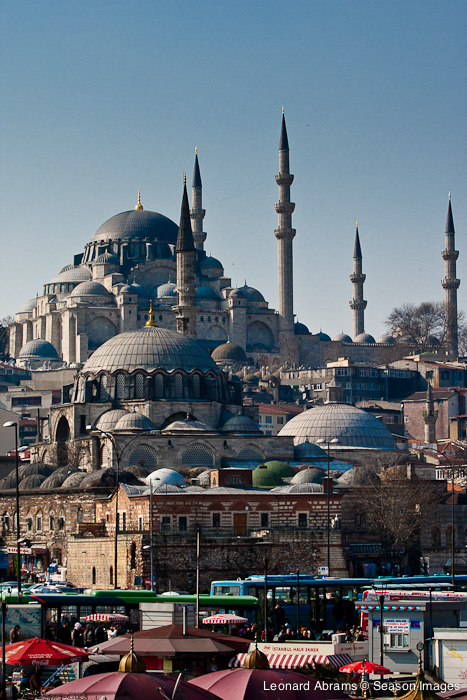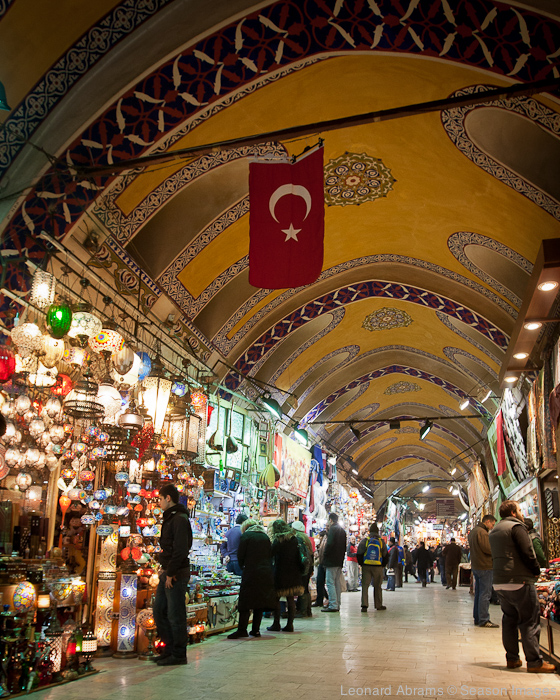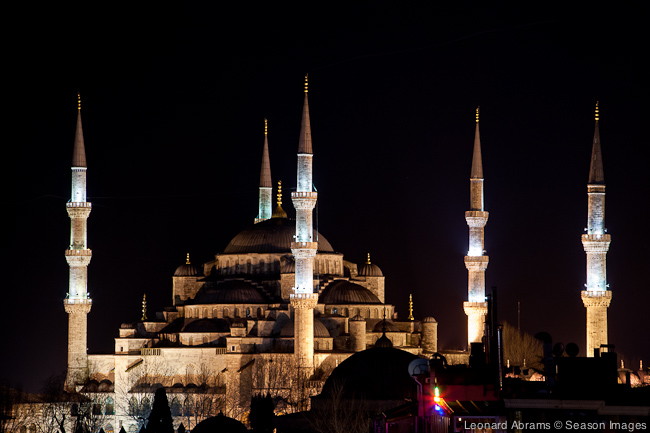A visit to Istanbul
This is the sixth and final blog derived from a three-day visit to Istanbul in February 2012.

Here is a small selection of shots taken around Istanbul – three days is definitely not enough time.
BLOGThis is the Blog of Season Images which belongs to photographer Len Abrams, ARPS
This is the sixth and final blog derived from a three-day visit to Istanbul in February 2012.

Here is a small selection of shots taken around Istanbul – three days is definitely not enough time.
This is the fifth blog derived from a three-day visit to Istanbul in February 2012. When (not if) you visit Istanbul, you must visit the Grand Bazaar and the Spice Market in the Old City, – and do also spend some time in the poorer, non-tourist shopping precincts of the city, preferably on a Saturday when it is really busy. Photographing these scenes and the people in them has to be discretely done which is difficult with a Canon 1DMkIII and Canon EF16-35mm f/2.8L II USM lens – hand-held with only available light.
 You thought the Shopping Mall is a modern concept – think again!! The Grand Bazaar in Istanbul is one of the largest and oldest covered markets in the world, with more than 58 covered streets and over 4,000 shops which attract between 250,000 and half a million visitors daily. The grand bazaar began construction in 1455 and opened in 1461. It is well known for its jewellery, pottery, spice, and carpet shops. Many of the stalls in the bazaar are grouped by the type of goods, with special areas for leather coats, gold jewellery and the like.
You thought the Shopping Mall is a modern concept – think again!! The Grand Bazaar in Istanbul is one of the largest and oldest covered markets in the world, with more than 58 covered streets and over 4,000 shops which attract between 250,000 and half a million visitors daily. The grand bazaar began construction in 1455 and opened in 1461. It is well known for its jewellery, pottery, spice, and carpet shops. Many of the stalls in the bazaar are grouped by the type of goods, with special areas for leather coats, gold jewellery and the like.
Today, the grand bazaar houses two mosques, two hamams, four fountains, and multiple restaurants and cafes. The sprawling complex consists of 12 major buildings and has 22 doors.
 The Spice Bazaar is one of the oldest bazaars in the city and is the second largest covered shopping complex after the Grand Bazaar. The bazaar was (and still is) the center for spice trade in Istanbul. The structure was completed in 1660 and is an “L”-shaped building, consisting of 88 vaulted rooms. The streets surrounding the market are also occupied by hundreds of small shops selling almost anything.
The Spice Bazaar is one of the oldest bazaars in the city and is the second largest covered shopping complex after the Grand Bazaar. The bazaar was (and still is) the center for spice trade in Istanbul. The structure was completed in 1660 and is an “L”-shaped building, consisting of 88 vaulted rooms. The streets surrounding the market are also occupied by hundreds of small shops selling almost anything.
This is the fourth blog derived from a three-day visit to Istanbul in February 2012. We flew from Gatwick in England to Istanbul on Turkish Airways and it was great. Spanking new planes, good food, pleasant crew. Much better than the bucket airlines and not too expensive. No extras such as checked in luggage costs etc.
The Chora Church was initially constructed very early – The original church on this site was built in the early 5th century, and stood outside of the 4th century walls. The majority of the fabric of the current building dates from 1077–1081. It is a smaller building than many of the other examples of Byzantine architecture in Istanbul. Around fifty years after the fall of the city to the Ottomans in 1453, the church was converted into a mosque and the art work was plastered over. In 1948 the building ceased to be a mosque and in 1958 it opened as a museum.
The impressive decoration of the interior was carried out between 1315 and 1321. The mosaic-work is the finest example of the Palaeologian Renaissance. The artists remain unknown. There are some 45 different frescoes and paintings.
This is the third blog derived from a three-day visit to Istanbul in February 2012. Visiting Istanbul in February or March turned out to be a good idea. Many fewer other tourists and much cooler (almost too cool with a day of snow!).
One of the drawbacks / challenges of photographing the amazing Mosques and Byzantine architecture was that they do not permit the use of tripods – not even monopods. I should have had a beanbag – I did get a fair number of lengthy exposures (8-10 secs) by placing the cameras on the floor, against pillars etc. and using a remote release.

The Süleymaniye Mosque was built between 1550 and 1558. It has blended Islamic and Byzantine architectural elements. It combines tall, slender minarets with large domed buildings supported by half domes in the style of the Byzantine church Hagia Sophia. The interior of the mosque is almost a square, 59 meters in length and 58 meters in width, forming a single vast space which creates an inspiring place of worship and prayer. The dome is flanked by semi-domes, and to the north and south arches with tympana-filled windows, supported by enormous porphyry monoliths. It was a privilege to be able to visit this amazing place.
This is the second blog derived from a three-day visit to Istanbul in February 2012. We stayed in the Old City at the “And Hotel” which was great – within walking distance of the main sites of interest, one of which was the Blue Mosque.

This is a breathtaking building built from 1609 to 1616. Intricate patterns and designs cover virtually the entire interior. The mosque is popularly known as the Blue Mosque for the blue tiles adorning the walls of its interior.
The design of the Sultan Ahmed Mosque is the culmination of two centuries of both Ottoman mosque and Byzantine church development. It incorporates some Byzantine elements of the neighbouring Hagia Sophia with traditional Islamic architecture and is considered to be the last great mosque of the Ottoman architecture classical period. The architect has ably synthesized the ideas of his master Mimar Sinan, aiming for overwhelming size, majesty and splendour.